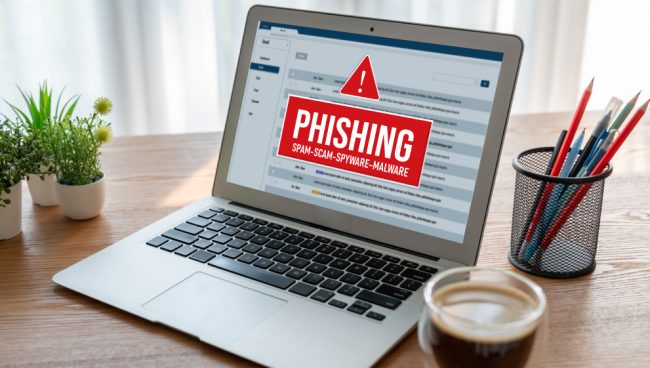
Imagine opening an email that looks exactly like it’s from your bank, warning you of a potential security breach and prompting you to act immediately. Your heart races, you click the link, and without realizing it, you’ve handed over your sensitive information to cybercriminals!
This scenario is a classic example of a phishing attack, a deceptive tactic used by scammers to exploit your trust and steal your data. Such phishing frauds are quite prevalent lately, and the only way to protect yourself is by learning about them.
This article covers all you need to know about phishing in cybersecurity so that you can stay vigilant and safe!
What is a Phishing Attack?
A phishing attack is a common cyber threat where scammers pose as legitimate organizations to trick you into sharing sensitive information. These attacks often appear as authentic emails, websites, or messages, aiming to steal your information.
Phishing in cyber security is a major threat because it manipulates human emotions and trust, making it one of the most widespread types of cybercrime.
How Does Phishing Work?
Phishing uses social engineering tactics to manipulate individuals into compromising their security. Here’s a breakdown of a typical phishing attack:
-
- Bait Creation: The scammer crafts a deceptive message or website that closely resembles a legitimate entity. This could be a fake email from a bank or a replicated website of a well-known retailer.
-
- Delivery: The bait is sent via email, social media, text message, or phone call. The message often includes a sense of urgency or a tempting offer.
-
- Hook: You engage with the bait by clicking a link, downloading an attachment, or sharing personal information on a fraudulent website.
-
- Capture: When you fall for the trap, the attacker captures your sensitive information, which can be exploited for identity theft, financial fraud, or additional attacks.
-
- Exploitation: The attacker uses the stolen information for destructive activities, including unauthorized transactions or distributing malware.
Common Phishing Techniques
Before delving into the specific types of phishing attacks, it’s crucial to understand the general techniques scammers use to deceive their targets. Here are some common types of phishing attacks:
Email Phishing
Email phishing is the most common form of phishing attack. Scammers send deceptive emails that appear to be from trusted entities like banks, online merchants, or professional contacts. These emails often prompt you to take immediate action, such as clicking a link to validate an account, reset a password, or download a document. The links redirect you to counterfeit websites that are designed to harvest login credentials or spread malware.
Spear Phishing
Spear phishing is a targeted variant of phishing. Scammers invest time researching their targets to craft personalized messages. For example, a scammer might pose as your company’s CEO and send an email requesting sensitive data or a financial transaction.
Types of Phishing Attacks
Phishing comes in various forms, each tailored to exploit different aspects of human behavior and technology. Understanding these types can help you recognize and avoid them.
Whaling
Whaling targets high-profile individuals, such as executives and senior management. These attacks can result in significant financial losses or data breaches due to the sensitive information or access obtained. Whaling emails are sophisticated and crafted to resemble legitimate business communications.
Smishing and Vishing
Smishing, or SMS phishing, and vishing, or voice phishing, use text messages and phone calls instead of emails to deceive people into giving out personal information.
What Are the Signs of Phishing?
Recognizing the signs of phishing can help protect you. Look out for:
-
- Unfamiliar Sender: Be cautious of emails or messages from unknown sources.
-
- Urgent or Threatening Language: Messages that create a sense of urgency or fear.
-
- Generic Greetings: Emails addressed with generic terms like “Dear Customer.”
-
- Suspicious Links: Links that don’t match the legitimate website’s URL or have slight misspellings.
-
- Attachments: Unexpected attachments, especially if they are executable files (.exe) or contain macros.
-
- Poor Grammar and Spelling: Many phishing emails have noticeable grammatical errors and spelling mistakes.
-
- Too Good to Be True Offers: Messages advertising remarkable deals or rewards that seem too good to be true.
Phishing attacks exploit human vulnerabilities to steal sensitive information. By understanding what phishing is and how these attacks work, you can better protect yourself. Familiarize yourself with common phishing methodologies like email phishing attacks and spear phishing, and learn to identify the signs of phishing. Always verify unsolicited communications and be cautious when sharing personal information online. Staying informed and vigilant is key to preserving your digital security.
Quick Heal to the Rescue!
Imagine you receive an urgent email from what looks like your bank, claiming that your account has been compromised. The email prompts you to click a link to reset your password. Without realizing it, you enter your login details on a fraudulent website.
Luckily, you have Quick Heal Total Security, which immediately detects and blocks the phishing site, saving you from a potential financial disaster. Quick Heal Total Security offers real-time protection, malware defense, and robust anti-phishing features to safeguard your digital life
-
- How many times have you experienced phishing attempts?
-
- Have you ever been a victim of a phishing fraud?
-
- What kind of email scams have you faced?
-
- Do you use any security software to protect against phishing?
Discover how Quick Heal Total Security can be your ultimate defense against phishing and other cyber threats. Get it now for just ₹3,165.00!
Related Products:
Quick Heal Total Security for Mac
Quick Heal AntiVirus for Server

